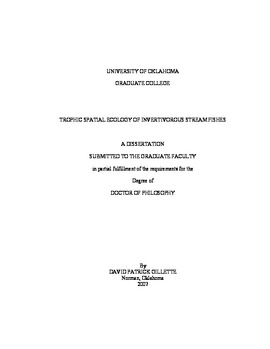| dc.contributor.advisor | Matthews, William, | en_US |
| dc.contributor.author | Gillette, David Patrick. | en_US |
| dc.date.accessioned | 2013-08-16T12:21:00Z | |
| dc.date.available | 2013-08-16T12:21:00Z | |
| dc.date.issued | 2007 | en_US |
| dc.identifier.uri | https://hdl.handle.net/11244/1292 | |
| dc.description.abstract | In Chapter 1, I studied the relationship between Bigeye Shiner populations and variables of habitat patches within the stream, and the land adjacent to the stream (the riparian zone). This work was done in Brier Creek, a small stream in southern Oklahoma. Results showed that the number of Shiners in a pool was best predicted by habitat variables of the riffle just upstream from a pool. These riffle variables also determined the amount of insect larva drifting from riffles into downstream pools at night, which in turn predicted Shiner feeding success. Body condition of Shiners was best predicted by feeding success. These results illustrate the importance of upstream riffles to the pool-dwelling Bigeye Shiner, and provide an example of how feeding habits can lead to importance of patch context for a species. When animals consume resources originating in other habitats and "imported" into their occupied patch, connections among habitat patches are important to the species' survival. | en_US |
| dc.description.abstract | In Chapter 3, I asked if feeding habits of different fish species determined their dependence on insects entering the stream from the riparian zone (terrestrial insects). Using experimental streams, I excluded these insects from half of the experimental units for each fish species, and examined differences in fish diet and body fat. Under terrestrial insect exclusion, diet and body fat of the bottom-feeding Orangethroat Darter were unchanged. Bigeye Shiner switched their diet from terrestrial insects to aquatic resources, but body fat levels did not change. Blackstripe Topminnow also switched their diet away from terrestrial insects, but, unlike Bigeye Shiner, body fat levels decreased when terrestrial insects were unavailable. These results indicate that reducing movement of trophic resources from one habitat to another affects different species in different ways, and that the feeding habits of species may help predict this response. This result is important in light of human landscape modification, which often alters the amount of insects moving into streams from the surrounding landscape. (Abstract shortened by UMI.) | en_US |
| dc.description.abstract | In Chapter 2, I studied differences in feeding ecology among populations of Orangethroat Darters on riffles in Brier Creek. Results showed significant differences among riffles. The number of prey items consumed varied significantly among riffles, but was not affected by darter body size. Prey selection varied greatly among riffles, and for four of seven prey items was explained by habitat differences. Contrary to theoretical predictions, diet breadth of darters within riffles was not dependent on the abundance of energetically favorable prey, largely due to a lack of selection for these prey items. These results indicate that variation among riffles can have a strong effect on prey use by the Orangethroat Darter, and that this is an important spatial scale over which to study diet variation in this and similar species. | en_US |
| dc.description.abstract | In my dissertation research, I investigated the manner in which trophic ecology links organisms to different habitats within the landscape. I studied three species: the Orangethroat Darter (Etheostoma spectabile), a fish that lives on the stream bottom and feeds on insect larva and other invertebrates; the Bigeye Shiner (Notropis boops), a minnow that swims in the middle of the water column and feeds on insect larva drifting downstream and terrestrial insects falling into the stream, and the Blackstripe Topminnow (Fundulus notatus), which swims just below the water's surface and feeds on insects falling into the stream from streamside vegetation. | en_US |
| dc.format.extent | xvii, 108 leaves : | en_US |
| dc.subject | Habitat (Ecology) | en_US |
| dc.subject | Orangethroat darter. | en_US |
| dc.subject | Biology, Ecology. | en_US |
| dc.subject | Spatial ecology. | en_US |
| dc.subject | Fundulus. | en_US |
| dc.subject | Notropis. | en_US |
| dc.title | Trophic spatial ecology of invertivorous stream fishes. | en_US |
| dc.type | Thesis | en_US |
| dc.thesis.degree | Ph.D. | en_US |
| dc.thesis.degreeDiscipline | Department of Biology | en_US |
| dc.note | Adviser: William Matthews. | en_US |
| dc.note | Source: Dissertation Abstracts International, Volume: 68-12, Section: B, page: 7768. | en_US |
| ou.identifier | (UMI)AAI3291251 | en_US |
| ou.group | College of Arts and Sciences::Department of Biology | |
